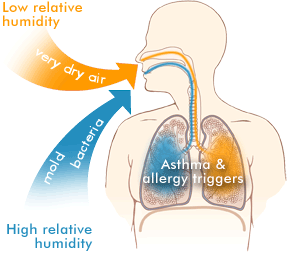Humidity Control
Here is what you get exclusively from | |
|
1-866-234-6630 Best prices. We will not be undersold. We also offer a price match policy to prove it. We offer online customer support! Any questions are answered by phone or email either instantly or within hours, not days. |

What is a comfortable humidity level for my home? How about for the office or even a classroom for teachers? How do you know if the humidity level is too high or low? Consult the humidity control experts at Allergy Be Gone. We can answer all your questions so that you have the healthiest humidity level in your home, office or classroom that will help ease your allergy and asthma symptoms.
When the humidity level is too high, it can cause problems and the same can be said about a low humidity level. Just like other facets in life, comfortable humidity levels are all about balance. At Allergy Be Gone, you will find the balance and get optimal humidity levels in your environment that will make you and those around you healthier.
- Effects of high humidity
- Effects of low humidity
- How to keep track of humidity levels
- How to deal with improper humidity
- Humidity infographic
- Where to find more information
See also:
- Allergy & Asthma Avoidance Information
- Dust Mites Information Page
- Mold Information Page
- Humidifiers Information Page
- Dehumidifiers Information Page
- Portable A/C Information Page
During the winter months, humidity levels are low (sometimes very low). However, these levels skyrocket during the summer months. The high humidity during the summer reduces the rate of evaporation of moisture from our bodies. Since our body relies on that effect to cool itself, without it we can feel uncomfortable. In the winter, the air is generally very dry. This causes moisture to be drawn from our skin making us feel even colder.
Effects of high humidity
Humidity is considered too high when its level goes above 45% - 50%, sometimes as high as 80% and up.
High humidity can be especially dangerous when combined with high temperature - as mentioned above, high humidity disrupts the body's ability to cool itself, which may lead to a heat stroke. Exceptionally high humidity can also trigger asthma symptoms. Therefore, people with heart problems or asthma are advised to be extremely careful during such conditions.

Another unpleasant effect of high humidity is the appearence of mold. High humidity makes it easier for molds to reproduce, and they can appear virtually anywhere, damaging whatever they grow upon. Mold spores also pose a threat for allergy and asthma sufferers.

Dust mites also thrive when the humidity is high. Present in almost every home, these tiny pests are yet another nuisance for people with allergies and asthma.
See also:
Effects of low humidity
Humidity levels under 35% can have several effects on your health, which may range from discomfort to serious complications. A common sign that your air is too dry is when your nose, throat and skin feel dry and scratchy. Insufficient moisture in the air makes the mucous membranes inside your nose and throat - your organism's first barrier against airborne infections - dry and more susceptible to diseases like cold and flu. Dry air is also dangerous for allergy and asthma sufferers, since it can aggravate their symptoms.
Another effect of dry air is the one it has on your surroundings:
- Hardwood floors, wooden furniture and expensive musical instruments lose moisture and contract when the air in a home is extremely dry. This can cause them to develop cracks or for the floor to separate at the seams.
- Static electricity is a direct result of dry air. In addition to causing painful shocks, it can damage computers and other electronic equipment.
- Houseplants suffer from dryness caused by low humidity.
- Wallpaper may peel at the edges if the air in a home is excessively dry
As mentioned above, low humidity can make you feel as if the air temperature is lower than it actually is. Since low humidity usually happens during winter months, maintaining a proper humidity level can even save you a bit on heating bills!
How to keep track of humidity levels
The simplest way to tell that there is something wrong with the humidity in your home or office is if you experience any of the symptoms described above. Also, keep an eye out for the following:
- High humidity can be present:
- During summer months
- In areas located near waterfronts
- After continuous rains and/or flooding
- In rooms with plumbing running through them (kitchens and bathrooms), especially if there are leaking pipes present
- In undergrounds facilities (basements)
- In rooms with poor ventilation
- Low humidity can be present:
- During winter months
- In areas with no large bodies of water present
- In rooms and buildings with excessive air conditioning
Although the best and most accurate way to keep track of humidity levels is using a hygrometer - a device specifically made for measuring humidity.
How to deal with improper humidity
High humidity:
- If excess humidity is caused by leaks in plumbing or roof, fix any water problem or leaks before doing anything else.
- Proper ventilation is very important when dealing with high humidity. Air your home frequently, especially the rooms you spend most of your time in (like bedrooms). Using a portable air conditioner, you can direct a flow of fresh air right where you need it. Make sure that places like bathrooms and basements, which tend to have high humidity levels, also receive a constant influx of fresh air.
- While air conditioners can remove moisture from the air to a certain degree (and still others have built-in dehumidification capacities), dehumidifiers are designed specifically for this task. You can use them to quickly reduce moisture level within a given area. Powered models work best in larger areas like living rooms and basements. Non-electric dehumidifiers can be used in smaller enclosed spaces like closets and bathrooms.
Low humidity:
- Turn off any excessive air conditioning.
- There are many ways to introduce moisture into the air - some of them might include using water sprayers, boiling water on a stove, placing pots with water in the rooms, or even leaving the bathroom door open with the bathtub filled with water.
- The most comprehensive way to solve the low humidity problem is to use a humidifier - an appliance that introduces water vapors into the air. They come in all shapes and sizes, from small tabletop models to whole house console versions to ones connected directly to your home's ventilation, heating or A/C system.

Where to find more information
See also:
- Allergy & Asthma Avoidance Information
- Dust Mites Information Page
- Mold Information Page
- Humidifiers Information Page
- Dehumidifiers Information Page
- Portable A/C Information Page






